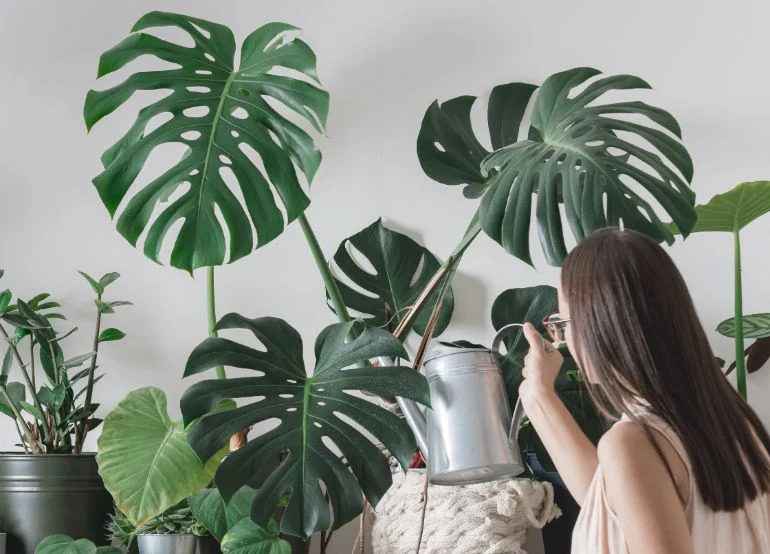Monstera Watering Schedule

Monstera Watering Schedule.The famous Monstera plant is an awesome, beautiful plant that loved for its unique look and laid back style. In this topic we will talk about how you should water your Monstera plant and not over or underwater it.
As said before almost everywhere, the trick is to water your plant only when top 3 or 4 inches of the soil is dry and it is almost every 14 days it doesn’t matter if it`s summer time or winter time if you keeping your plant indoor the watering schedule is same. But be careful, the safety of your plant is not just about watering, there are some other elements that you should pay attention to them too.
Saying again the best time to water you Monstera plant is when the soil dries out, also you need to be sure that the pot or container that you are keeping you Monstera in has good drainage hole so your plants roots don’t rot.
Here are some signs that tells you to stop watering your Monstera:
- If your Monstera`s leaves turn to yellow
- There are signs of black spots on the stem
- The soil that you keep your plant in is wet
Depending on your plants size and the pot or container that you keep your plant in the amount of wwater that you need to give to the plant differs, but generally speaking if you see water is dripping from the drainage hole underneath. Keep in mind that if your soil is not well prepared it will look very solid and water will not go through it.
Monsteras are easy going plants so you don’t need to special things between every watering just clean the soil of fallen leaves and spray water on it, occasionally.
If you are propagating Monstera and don’t know how to water it well it is easy, if you are propagating in soil only thing you need to be sure of is to water it till the soil is moist, not wet.
If you repotted your plant after repotting give the plant good soaking straight water and wait to soil get completely dry and then water it properly.
If you don’t know when you need to water your Monstera, just pay attention if the leaves starts to curl, droop or crisp up at the edges, if you see these signs then your plant needs watering but careful not to overwater it.
You can also mist your Monstera so that you help it to hydrate leaves and provide humidity, though over doing it will result in decay and fungal infections.
There is a common question between people and that is, can yellow Monstera leaves turn green again? The answer depends on the situation of the plant, most Monstera plants that suffered that over or underwatering will not gain back their original color, but if a plant that suffered the same situation but not damaged so bad and just got a bad look will look good again if you water it properly.
if you have any intentions to keep your Monstera plant in water i have to tell you that it is not a good idea, it is ok to keep it for short period of time but if you want to grow it in water the bad news is they will die. with average room temperature which is 72 degrees Fahrenheit or 21 degrees Celsius it will thrive for almost three weeks and after that it will start to rot.
How often should I water a monstera?
Watering a monstera is crucial for its health and growth. They prefer moderate watering, which means watering when the soil feels moist one or two inches below the surface. To test this, use a finger test, a stick method, or a moisture meter. The finger test indicates that the soil is dry, while the stick method indicates that the soil is still moist.
To water a monstera, place it in the sink or use a watering can to slowly add water until it runs out of the drainage holes. Empty the drainage tray immediately and don’t soak the soil. Avoid getting the leaves wet by adding water to the soil instead of dumping it over the top of the plant.
Ensure your pot has excellent drainage and that the soil drains quickly. If the soil is compacted or water does not empty into the tray, switch to a better-draining soil. Additionally, ensure that your monstera gets plenty of bright, indirect sunlight to help it use water efficiently and dry out in a timely matter.
More monstera watering tips include using room-temperature filtered water or letting the water sit out overnight to evaporate chemicals like chlorine. You may need to adjust the amount of water to suit your plant’s needs.
In summary, Water every 1-2 weeks, allowing soil to dry out between watering. Expect to water more often in brighter light and less often in lower light. Pro tip: Monsteras can benefit from filtered water or water left out overnight before using.

Do Monsteras like to be watered a lot?
Monsteras prefer slightly moist soil and generally like to dry out just a bit between watering.
They are epiphytes with aerial roots (a plant that grows on another plant in its natural habitat), so they don’t tolerate soggy soil. For a rule of thumb, once the top 2 to 4 inches of the soil are dry, your Monstera could use some watering.
How many cups of water do you give monstera?
Monstera needs 0.8 cups of water every 9 days when it doesn’t get direct sunlight and is potted in a 5.0″ pot.
Signs of Overwatering
Signs that your monstera may be overwatered include dark brown spots on the leaves, yellow leaves or stems, fungus in the soil, and the soil taking more than 10 days to dry out. Dark brown spots are a sign of root rot, which can be treated to prevent its rapid spread. If you notice these spots and the soil is wet, remove the monster from its pot to check the roots. If you notice any dark, muddy or smelly roots, prune them back and gently remove as much of the old soil as possible before repotting in a clean, well-drained pot in clean, dry soil.
Signs of Underwatering
To know the signs of an underwater monster, check the following:
Monsteras often droop when they are thirsty, and if you notice limp and drooping leaves, check the soil for dryness. If the top few inches are dry, water your monstera. If the leaves are dry, give it a good watering and remove any severely damaged leaves.
Slow growth may be a factor, but consider other factors like lighting, fertilization, and soil conditions before overwatering. If your monstera is in a bright spot and you’re fertilizing regularly, monitor the soil to see how quickly it’s drying out and whether you need more water or water it sooner.
Curling leaves can also indicate underwatering and low humidity, so ensure your monstera isn’t near a heating or AC vent. If the soil retains moisture well, set up a humidifier before watering more. If the soil is compacted or plain dry, submerging may be the cause.
Yellowing leaves may also indicate underwatering, especially if it is accompanied by dry brown spots. Dark brown spots on yellowing leaves are most likely overwatered.
To determine if your monstera is underwater or overwatered, start with the soil. If the soil feels dry, compacted, or doesn’t absorb water well, underwatering is more likely. If the soil feels wet to the touch or if you notice a soaked root ball and rotting roots, it’s probably overwatered. If the soil feels damp but not overly dry or wet, your monstera’s issues might stem from something else.
If you’re unsure, use a moisture meter to check on the moisture level in the actual root ball, as the surface of the soil can feel bone dry while the root ball is still soaked. This can make diagnosing a monstera’s health problems more difficult.
Conclusion: overwatered vs underwatered monstera!
be sure to take a look at our other topics as well related to”Monstera Watering Schedule”
- How to hold up a Monstera plant
- Monstera turning yellow
- Can succulents stay outside in rain?
- Is Monstera toxic to dogs?
- Is monestra toxic to babies?
here you can download this article (Monstera Watering Schedule) in PDF:













4 comments on “Monstera Watering Schedule⭐100%practical-Videos-Pictures”
As soon as I found this internet site I went on reddit to share some of the love with them.
Hello good time
We are proud to have audiences like you
Thank you for your nice comment
See us again.
Great, thanks for sharing this blog post.Thanks Again. Really Cool.